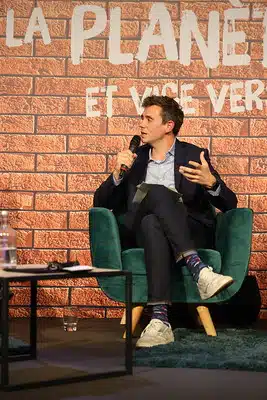Changing consumption patterns
Our societies have become obsessed with the act of purchase. People buy things they don’t need with money they don’t have to people they don’t know. The result is irrevocable; the planet’s finite resources are being inexorably depleted. According to Lidewij Edelkoort, founder of Trend Union, and Philip Fimmano, executive director and curator of Trend Union, the design is a way to alert people about this issue. The Covid-19 crisis is a pivotal moment. We must take advantage of the changes inherent in this crisis to bring about a paradigm shift. The industry must change, whether in its production process or in the nature and use of materials.
Many new approaches are developed, seeking to reorganise processes and to promote a circular economy. With their interventions, the two speakers want to promote new development and new economic models through design. The design thus turns to the human hand to give shape and express deep dismay. Indeed, industrial mass design as we know it has recently become superfluous. People are eager to rework materials and products. They no longer want to depend on subsidiaries on the other side of the planet. Their exhibition called “La Manufacture: a labour of love” is located in the Gare Saint Sauveur in Lille, a city with a rich textile past. The term “manufacture”, referring to an old fashion term, is not insignificant. Nowadays factories are seen as polluting our lives by releasing dangerous gases, increasing visual pollution … But the design could help to rethink our relationships with them. We must see them as seniority with which it is possible to make something new. Further developments will depend on our ability to take the best from the past to think about the future.
Recovering the value of time and space
As Philip Fimmano outlines, all is about speed since the 1990s. Everybody wants everything to go fast. This obsession with rapidness is questioned in the exhibition. All the designers are trying to think about how to slow down production, as the idea of “mass production” has become obsolete. Being responsible for our planet is all about the slowing down of the production and consumption. Although it is hard for the designers to know how to get rid of overconsumption, they rather aim for an article-by-article production.
The design could also have a local meaning. Most regions of the world are deindustrialized as they relocated their production. This leads to a lack of self-sufficiency. Nobody wants these models, in which everything is about volume, anymore. Especially with the awareness brought about by the health crisis, production will become increasingly local. The pandemic made us rediscover our regions by traveling locally, discovering local brands and the need for self-sufficiency in case of emergency. We need to create a new way of doing things and establish this short circuit between producers and consumers. Small local production units will also be able to recreate jobs for people.
A second life for the products
This exhibition aims to show that we are in the in-between. We need to find new ways to take care of the planet, people and things. It explores the experiments of a new generation of designers around materials and manufacturing processes. Working in fashion gives designers a great deal of influence. These new designers think about ways to better consume but also to “co-design” with nature. Therefore, the exhibition was a project seeking to recycle the materials and waste piled up in our land and seas. They don’t see nature as a natural material but as a partner, a physical and technical inspiration. We need a process that mimics nature because it is a stable source of knowledge. Philip Fimmano highlights how these new generations can lead to a better future. The expression “Labour with love” illustrates that people love what they do, because they don’t use finite natural resources; they clean up the mess and recycle. It is this “circular philosophy” that comes out of this new generation.
Moreover, the concept of new materialism underlines the importance of showing more compassion and respect. By getting rid of all marketing, it will be possible to build responsible products. Lidewij Edelkoort and Philip Fimmano agree that objects must be given a soul. That way people will choose them more carefully and keep them longer.
The design is therefore a great tool to express the need for a paradigm shift. The work of this new generation of designers, the driving force behind a new circular economy, is striking. The different parts of the exhibition allow us to understand these new modes of local, responsible and more humane production that need to be developed.
Ninon Paulissen



